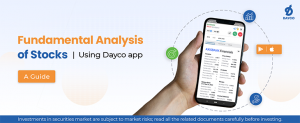Exploring Fundamental Analysis of Stocks With Dayco Securities
![]() July 15, 2023
July 15, 2023
![]() 0 Comments
0 Comments
There’s an old adage - “If you fail to plan, you plan to fail.” This is true in stock investing and stock trading as well. Investing in stocks entails thorough research on companies listed in NSE and BSE. However, this research can prove to be quite time intensive and cumbersome. There are so many financial and operational aspects of a company. Making sense of all these aspects, even for a handful of companies, can be exhausting and cumbersome. But when you invest or trade with Dayco Securities, you have every fundamental analytics tool at your disposal. No need to go to multiple business sites, download company reports, or tune in to those business news channels. The Dayco Securities stock trading and investing app offers a 360-degree suite of fundamental analysis tools. This guide will practically explore how you - the user- can leverage the fundamental analysis tool to make data-driven investing decisions.
Easy Access to Fundamental Analysis
With just two clicks, you can access the fundamental analysis page for any stock traded at NSE and BSE. Here’s the workflow
Step 1: Open the Dayco Securities App. If you are not already on the watchlist tab, click on it.

Step 2: Tap on any of the stocks listed under Nifty, Sensex, BankNifty or FinNifty. Once tapped, you will be presented with four options. See the image below. We tapped on the scrip of Titan -

Just tap on the Info icon marked with the blue arrow in the image above. That’s it! You are now in the Fundamental Analysis launch screen!
You will find three tabs in this screen -
- The Market Depth tab
- The F&O tab
- And the main Analysis tab

The Fundamental Analysis Launch Screen
For this blog post, we will focus on the main Analysis tab. It looks like this -

[Pro tip: If you want to research on a stock that’s not listed under the pre-built indexes, you can create your own watchlist by clicking on the + icon beside those prebuilt Nifty or Sensex indexes. Once clicked, you will see a tab with a number on it - on the left-hand side of the pre-built indexes. Click on the number to enter your custom watchlist. You will find a search field. You can use it to find any stock you want to perform research on].
How To Use Dayco Securities Fundamental Analysis Screen
Let’s recap how we can access the Fundamental Analysis screen -
- To choose a stock for fundamental analysis, you can- either go to the prebuilt indexes in the Dayco Securities app home screen or you can create a custom watchlist and search for your desired stock.
- Tap on the stock or scrip and then tap on the Info icon denoted by the symbol - i
Now you are in the Fundamental Analysis launch screen. Choose the tab named ‘Analysis’.
Now that you are in the Fundamental Analysis screen, you can see how each and every Fundamental ratio, metric and percentage about the chosen stock is right on your screen.
All these Fundamental Metrics are neatly organized into 7 heads -
- Valuation
- Price History
- Dividends
- Balance Sheet
- Margins
- Income Statement
- Operating Metrics
Let’s explore each of these categories one by one and learn how the financial metrics in each of them empower us to make data-driven investment decisions.
1) Fundamental Analysis Based on Company/Stock Valuation
All that glitters is not gold. This is specifically true for companies listed in the stock market. A listed company can ‘appear’ attractive and valuable. However, the true valuation of a company shows the true picture. As per regulations in India, every listed company has to publish some key metrics that transparently shows its TRUE performance and value.
Conversely, a company might appear not so attractive in terms of value due to some recent events. But maybe it is fundamentally strong. Looking at the valuation metrics will enable you to understand its actual value.
In summary, understanding the valuation of a company will help you understand if the company is undervalued or overvalued.
Valuation Metrics In The Dayco Securities App

Look at the valuation box marked in blue. Every metric that’s needed for an investor to make an idea about the true valuation of the company is there for you to leverage.
Let’s explore some of the most popular valuation metrics used by seasoned investors using the example image above.
1. A. Price To Earnings Ratio or P/E Ratio:
Look at the seventh item in the valuation box. That’s the P/E ratio for the selected stock. In the example image above, you can see the P/E ratio for the stock - Titan.
Formula - (Total number of stocks available in the market * stock price) / Earnings of the company in a given financial year
So, as of 13th July 2023, Titan has -
- Total Outstanding Shares - 887.786 million
- Current Price - Rs. 3102.70
- Net Income - 32500 million
See the image below -

So, the total stock value of Titan stands at
887.786 * 3102 = 2,753,912.172
Divide this by net income and you’ll get 84.52. This is the P/E ratio of Titan.
How to Use P/E Ratio to Make Data Driven Decision
How do you know if the P/E Ratio of a given stock is on the higher or lower side? - You have to compare the P/E Ratio of the stock to the average P/E ratio of the sector to which the stock belongs to.
Here are some scenarios of decisions being taken by investors after seeing the P/E Ratio -
- A high P/E Ratio means that investors or traders are willing to buy the stock at a higher price than what’s justified.
- An investor can then assume that there is a consensus that the stock price will rise in the future, which is why people are buying at a higher price.
- Conversely, a value investor might see the P/E Ratio as a hint that the stock is overpriced. He or she might wait for a while before buying a stock.
- Again, if an investor sees that a fundamentally strong stock has a lower P/E Ratio, then that stock might be available at a bargain price.
Remember: You can’t base your entire purchase decision on P/E ratio. But it does give a clear idea about whether a stock is overpriced or underpriced.
1.B. Price to Book Value
The ‘Book Value’ is the value of a company's total assets after deducting the total value of liabilities and depreciation. This means that Book Value refers to the company’s value in the eye of the accountant.
In the Analysis screen, under the Valuation box, you will find this metric -

Formula:
Market Price Per Share / Book Value Per Share (You can find the Book Value per share by dividing the company’s Book Value by the total number of outstanding shares)
Things To Remember While Basing Your Investment Decisions On P/B Ratio
- Many times, the stock price of a company climbs way higher due to hype or volatile market conditions. You can use P/B Ratio to see if the price of the stock of a company is in line with the combined value of its assets.
- Just like the P/E ratio, you can use the P/B ratio to identify overvalued and undervalued stocks.
- One negative aspect of P/B Ratio is the fact that it takes into account the valuation of intangible assets of a company as well. Now, coming up with the actual or true value of intangible assets is extremely difficult, and there can be a huge grey area pertaining to this.
- Hence, you should use P/B Ratio to analyse the stocks of physical asset-heavy companies only.
2) Fundamental Analysis Based On Income Statement
The primary aim of every business is to make money. However, reporting how much money is being generated by a company can be done in various ways. And not every type of these reports shows the big picture. So, let’s find out how to leverage income statements to find the big picture - using the Dayco Securities app.

2.A. Total Revenue
In the Income Statement Box inside the Analysis screen, you will find the Total Revenue generated by the company you selected. It is the 9th item inside the income statement box.
In simple terms, income earned by a company from its normal day-to-day operations - like selling products or services - is called revenue. Other income, such as rental income, income from royalty or licensing etc, is also shown as revenue. But non-operating income is not shown as revenue.
Remember: Revenue does not take into account the expenses incurred by the company. Hence it does not show the entire picture.
2.B. Net Income
The fourth item in the Income Statement is the Net Income of the company selected. Net income is the amount of money a company is left with after deducting all the expenses and taxes from the revenue it earned. Hence it shows a clear picture of the actual profitability of the company.

Be Careful About Net Income.
Yes, Net Income shows the big picture. However, companies can sometimes indulge in accounting practices that impact the true reporting of the net income. For example, a company can show a certain expense as an asset - thereby reporting higher than actual net income. Hence, you must be vigilant while examining the net income generated by a company.
2.C. Basic EPS or EPS
To understand Basic EPS, you first need to know what the weighted average of total outstanding common shares is.
Suppose in the Indian financial year (April 1 to March 31st), for the first three months out of 12, a company has a total outstanding shares amounting to 100. In July, the company issued 100 more shares. So, for 9 out of 12 months, it has total outstanding shares amounting to 200.
Now you can calculate the weighted average of the common shares this way -
(100 * 3/12) + (200 * 9/12) = 25 + 150 = 175
Now, to calculate Basic EPS, you just need to divide the selected company’s net income by the weighted average number of shares.
Pros and Cons of Basic EPS
- Basic EPS hints at the company’s performance. It shows the basic earnings of a company on a per-share basis.
- It is useful to measure the performance of companies and is also one of the important metrics in calculating the P/E
3) Fundamental Analysis Based on Net Margin
We have explained what revenue and net profit are. Now, when the net income of a company is shown as the percentage of the revenue it generated, we get Net Margin.
See the image-

You can see the Net Profit and Total Revenue of Titan. Divide the Net Profit and Total Revenue and multiply the result by 100. See if the output matches with the Net Margin marked in blue.
Making Sense of Net Margin
- Net Margin is usually represented as a percentage
- The closer it is to 100, the more effective is the company to sell its products and services
- But please don’t use the metric independently. Use other metrics to get some more context. Since Net Income can be influenced by questionable accounting practices, the Net Margin metric can also be influenced.
4) Fundamental Analysis Based on Balance Sheet
The assets and liabilities of a company show us its true net worth. These two metrics can also be used to know how liquid a company is. The assets and liabilities make up the balance sheet of a company which should be examined by a potential investor.

4.A. Current Ratio
When you divide current assets by current liabilities, you get the current ratio.
For example, the total value of current assets of Titan is 224,070 million INR (as of 31st March 2023) and the total value of current liabilities is 132,640. Dividing the current asset by current liabilities, we get - 1.68. Look at the image above. Does the output match with the current ratio shown?
Making Sense of Current Ratio
- As you can see, Titan has more assets than its liabilities. This is why it has a current ratio of more than 1.0. This is good. This means that the company is liquid and can pay off its short-term debt easily.
- Companies that have more liabilities than assets will have a current ratio of less than 1.0. This is bad because it means that they have no ability to pay off short term debt quickly.
- A company can fool investors by showing the value of inventory as assets. An inventory full of unsellable products means that the company will have a hard time converting the inventory value to cash in order to pay off the short-term debt. A wrongly shown assets and liabilities report will negatively influence the current ratio. A more stringent metric like quick ratio can be used in this case, which omits the inventory.
4.B. Debt To Equity Ratio
Debt to Equity Ratio is yet another useful metric that you can find under the Balance Sheet box in the Dayco Securities Analysis screen.
Formula For D/E Ratio:
(Total liabilities) / (Total Shareholders’ Equity)
Note: Shareholder equity can be found by subtracting liabilities from assets.
Making Sense of the D/E Ratio
- D/E Ratio is interesting. Both high and low D/E Ratio are bad. A high D/E Ratio means that the company relies on debt a little too much. On the other hand, a little too low D/E Ratio means that the company isn’t leveraging debt to finance itself.
- To understand whether a stock’s D/E Ratio is high or low, you have to compare it with the D/E ratio of competitor stocks in the same sector.
5) Fundamental Analysis Based On Operating Metrics
Operating Metrics is yet another set of KPIs that enable investors to gauge the performance of a stock

5.A. Return On Assets
ROA, or Return on Assets, is calculated by dividing the net income of a company by the assets it boasts of. It gives us a hint about how well a company is leveraging its assets to generate profits.
5.B. Return on Equity
When you buy the shares of a company, you are basically giving money to the company. Ever wondered how much profit a company is generating by utilising your money? This is exactly what Return on Equity (ROE) is all about.
ROE is calculated by dividing net income by average shareholders’ equity.
You can have a fairly good idea about the management’s effectiveness in using available equity to generate profits using ROE.
As you can see, the Dayco Securities app comes with each and every financial metric that’s needed for an investor to make a data driven investment decision. However, that's not all. We also have a dedicated Market Section page that will further enhance your Fundamental Analysis endeavour with real time data, company news, and graphical charts.
Leverage these financial metrics to your advantage. Be an aware investor who can't be taken advantage of.
If you have a question, share it in the comments below or DM us or call us – +91 9051052222. We’ll be happy to answer it.
Share With
I'm a cool paragraph that lives inside of an even cooler modal. Wins!
Are you sure?
In case you didnt know, you can open your account online within 24 hours. Offline account opening takes up to 4 working days. If you wish to open your account offline, fill and sign the forms using a black/blue ballpoint pen. Please fill in the email and mobile number of the applicant to avoid account opening delays.
Enter Password
Please enter your details and password
New to Dayco?
Enter Password
Please enter your details and password
New to Dayco?
Filing Complaints on SCORES (SEBI) – Easy & Quick
- Register on SCORES Portal (SEBI)
- Mandatory details for filing complaints on SCORES:
- Name, PAN, Address, Mobile Number, E-mail ID
- Benifits:
- Effective Communication
- Speedy redressal of the grievances
Thanks !!
Your details were successfully received.

Thank you for Your Feedback!
Our Team is working constantly on improving our user experience and your feedback really means a lot.
Thanks !!
App Link Send to your mobile number successfully.
Thank You
All your Questions have been recorded
Thank You
All your Questions have been recorded
Thank You!
Thank you for your response. We'll get in touch with you at the earlisest for your investment planning needs
NEXT
Thank You!
Thank You for your interest in our Moderate Equity Portfolio. Please find below the credentials to track this portfolio:
User ID: mockmod@daycoindia.com
Password: abcd@1234
Portfolio Tracker
Please Read!
Risk profiling is crucial for identifying and managing potential risks in investment decisions. Please carry out your risk profiling before making any investment decisions.
Complete Risk Assessment Now
Thank You !!
Please enter your details to download/print the report
Thank You !!
Please enter your details to download/print the report
Thank You !!
Please enter your details to download/print the report
Thank You !!
Please enter your details to download/print the report
Thank You !!
Please enter your details to download/print the report
Set Your Goal
Please Select an option from below
Set Your Goal
Please Select an option from below
Thanks You !
We appreciate your interest in our services. Our team will be in touch with you shortly.
CloseSet your Goal
Please enter your details in the fields provided
Thanks You!!
Calculation report has been sent to your mail id successfully
Clear form?
This will remove your answers from all questions and cannot be undone.



 Book Appointment
Book Appointment









Leave a Reply